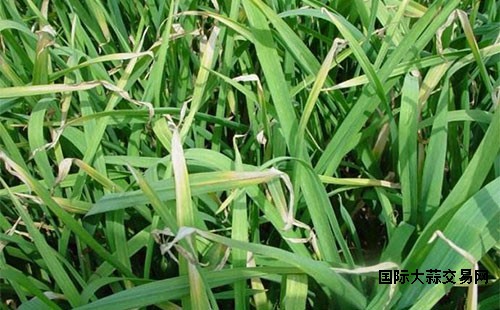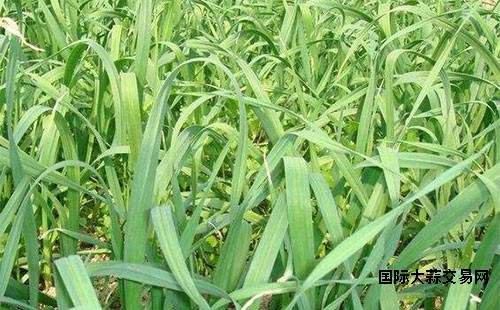In recent years, continuous cropping garlic field in spring is prone to disease, and there is an increasing trend. Field performance: garlic leaves yellow and wilting, curling and other symptoms, individual plots incidental to other fields, then gradually spread, especially after the rain and fog, the progression of the disease quickly. Remind garlic farmers must pay attention to prevention and control.

I. symptoms of garlic blight
Garlic disease mainly damage leaves, early onset in the central tip or blade appears white to yellow water spots, light green edge, soon after the lesion expansion, resulting in half leaf to the whole leaf withered. From 3 to 5 and a half days leaves or whole leaf wilting, high humidity spot rot, produce sparse grey white mildew on the stems of infected was hygrophanous rot caused by whole plant.
Two, the pathogen and occurrence regularity of garlic blight
Garlic onions for Phytophthora Blight fungal pathogen, fungi belonging to mastigomycotina. The pathogens overwinter in the diseased body or soil with mycelia and spores. When the conditions are suitable for early spring, the spores of bacteria are infected and re infected with the wind, rain, irrigation water and fog.
The causes of disease of garlic bulb swelling and bolting ability is insufficient, thereby affecting the yield and quality. Continuous plots, soil sticky, poor drainage, easy to water, the use of immature organic fertilizer, planting density is too large, field closed canopy, long-term low temperature and rainy, heavy incidence.
Three. Influencing factors of garlic blight
1 climate
Large amount of precipitation, fog and the number of high temperature easy onset, usually in the temperature of 25 DEG to 32 DEG C, relative humidity is higher than 95%, and a drop of water under the condition of the existence of heavy disease.
The disease occurred seriously in the period from 4 to May, but due to the recent warm weather frequent rainfall, increased frequency of precipitation, fog and haze days, increasingly early onset period, if the morning dew more, the incidence is more serious.
2. Variety and sowing date
There were some differences among different breeds. The sowing time is too late and the damage is serious. According to local conditions, timely sowing is the key link.
The roots of early sowing garlic are good, and they are less susceptible to disease. The late planting garlic is weak before winter, the root system is not developed, and the disease resistance and stress resistance are bad, and the disease is easy to be infected the following year.
3, fertilizer management
Under different conditions, the incidence of poor fertility is heavy. The diseases of organic fertilizer, phosphate fertilizer and potash fertilizer were lighter, while those with excessive nitrogen fertilizer were more serious.
Soil moisture also had a great influence on the occurrence of Phytophthora blight. More watering, large field humidity prone to disease, for this purpose, watering depends on soil moisture content and weather changes.
Department of shallow ditch garlic mulch, soil moisture did not dissipate, in case of rain weather, the aggravation of the epidemic disease. Therefore, a deep trench should be used to lower the water table.
4, planting density
Garlic planting density is 35 thousand plants per acre planted, the greater density of disease more serious, mainly due to excessive density field, foliar coefficient, lower leaves, poor ventilation and light and humidity field, conducive to the rapid propagation of pathogenic bacteria.

Four, garlic epidemic disease in recent years prone reasons
The severe occurrence of the disease in 4-5 months, but due to warm winter, frequent climate, increasing rainfall, precipitation, fog and haze days, the incidence of early and late, and if more dew in the morning, the incidence is more serious.
From the sowing date of garlic, the early garlic root system is good, the disease is less harmful; the late planting garlic is weak before winter, the root system is not developed, the disease resistance and resistance ability is bad, and the following year is easy to be infected with Phytophthora blight. Soil moisture also had a great influence on the occurrence of Phytophthora blight.
Department of shallow ditch garlic mulch, soil moisture did not dissipate, in case of rain weather, the aggravation of the epidemic disease. Therefore, a deep trench should be used to lower the water table.
Five, garlic disease prevention measures
1, select more flat terrain, not easy to water plots cultivation; mulch mulch, blocking soil bacteria splash on the plant, reduce the chance of infection. Use high ridge cultivation to avoid water accumulation. Timely removal of disabled bodies in the field after harvest.
2, the ecological status of soil resistant varieties and soil biocontrol agent to improve the continuous cropping field, reduce the number and density of harmful bacteria; organic fertilizer, potash fertilizer and biological agents, enhance disease resistance and non garlic; or the Liliaceae vegetables rotation for more than 2 years;
3. Chemoprevention
At the early stage of the disease, using the following formula: fungicides or control 560g/L azoxystrobin chlorothalonil SC 2000 - 3000 times liquid; 72% C Nathan alnminum WP 800 - 1000 times liquid; 72%, cymoxanil mancozeb wettable powder of 600 - 800 times liquid; water spray. As the disease every 7 - 10 days 1.
The onset of widespread, may adopt the following fungicides or formula prevention: 66.8% C Nathan isopropyl SYP-1620 WP 600 - 800 times liquid; 72.2% propamocarb hydrochloride aqueous solution of 800 - 1000 times liquid + l0% Cyazofamid SC 2000 - 2500 times liquid; 50% Dimethomorph WP powder 1000 - 1500 times liquid + 75% chlorothalonil WP 600 - 800 times liquid; 440g/L Tricosadiynoic - chlorothalonil SC 600 - 1000 times liquid; enestroburin 25% EC 2000 - 3000 times liquid + 75% chlorothalonil WP 600 - 800 times liquid; 35% ene acyl and thirm WP 1000 - 1500 times liquid; 52.5% evil ketone cymoxanil WG 1500 - 2000 times liquid; 76% cream - generation aliette WP 800 - 1000 times liquid; water spray, treated every 1 times 5 - 7 days.






